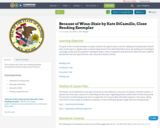
This outlines the 2-day close reading exemplar developed by Student Achievement Partners.
- Subject:
- Arts and Humanities
- Material Type:
- Lesson Plan
- Date Added:
- 11/11/2012

This outlines the 2-day close reading exemplar developed by Student Achievement Partners.
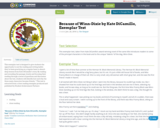
This exemplar text is designed to give students the opportunity to use the reading and writing habits they’ve been practicing on a regular basis to absorb deep lessons from Kate DiCamillo’s story. By reading and rereading the passage closely and focusing their reading through a series of questions and discussion about the text, students will identify how and why the three main characters became friends.
* This text is extracted from a close reading exemplar produced and published by Student Achievement Partners
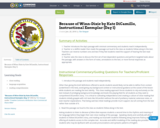
Because of Winn-Dixie by Kate DiCamillo, Instructional Exemplar (Day 1)
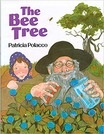
Do you ever get bored when reading? Mary Ellen does! Grampa knows just what she needs, a trip to the bee tree. With half the town following the chase, Mary Ellen and Grampa go off on an adventurethat leads Mary Ellen to make a sweet discovery of her own.Lexile Level: AD680LGuided Reading Level: MGenre: Fiction
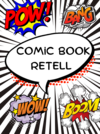
In this Unit Plan, Students will use Book Creator to create a comic of the story they have independently read in class. Students will independently use the resource I generated on how to use each function to create their comic. Then use the Criteria for Success ( cfs) to evaluate their own work, and share their work to peers.
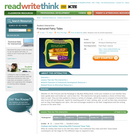
The Fractured Fairy Tale tool encourages students to create their own fractured fairy tales.

This lesson can be used with numerous pieces of literature, videos or cassette material to develop viewing and listening skills and the students ability to compare and contrast. One of the richest sources is in the area of fairytales and folktales. This an especially good source if you can find a modernized version in video or cassette form to contrast with the more traditional written form. I have used the "Frog Prince" because of this factor and because it was part of the 4th grade language arts reading unit.
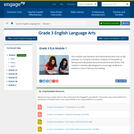
This module uses literature and informational text such as My Librarian Is a Camel to introduce students to the power of literacy and how people around the world access books. This module is intentionally designed to encourage students to embrace a love of literacy and reading.
Find the rest of the EngageNY ELA resources at https://archive.org/details/engageny-ela-archive .

In this eight-week module, students explore the questions: “Who is the wolf in fiction?” and “Who is the wolf in fact?” They begin by analyzing how the wolf is characterized in traditional stories, folktales, and fables. Then they research real wolves by reading informational text. Finally, for their performance task, students combine their knowledge of narratives with their research on wolves to write a realistic narrative about wolves.

Flor has been looking forward to summer with her best friend since last summer! But an unexpected twist of fate lands her working in her family’s mattress store and her best friend at band camp. Herlife gets even worse when she has to compete in the local honey pageant (again) and volunteer to help a recluse beekeeper with her worst frenemy. With her parents fighting and the possibility of moving to New Jersey on the horizon, this summer cannot get any worse.Grade Level: 3rd-7thLexile Level: 870LGuided Reading Level: SGenre: fiction, chapter book

A team of teachers at Centennial Elementary School in Olympia, WA, developed book boxes to share across the school each month centered on identifying feelings and developing empathy for others. Each month one or two picture book titles are paired with a Word of the Month. The media literacy teacher team developed materials, including a presentation slideshow, a video read-aloud, and discussion questions. The principal and teachers share the books with students, facilitating discussions for students to identify their own feelings and develop a toolbox for regulating emotions. Students use a Likert scale, developed by Jennifer LaGarde and Darren Hudgins, to identify emotional responses and develop vocabulary to describe and deal with their feelings. Titles and SEL connections are shared with families through the school newsletter.Centennial Media Literacy Teacher Team:Heather Slater, teacher-librarianJennifer KnightLuci StaffordAdam PearceShannon Ritter, principal
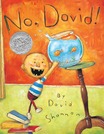
This lesson plan is mostly about students learning the wrongs and rights of everyday life and why it is important to always tell the truth along with reporting the situations to adults. This also gives an understanding of owning up to your mistakes and actions and learning how to decide the good and bad choices.

Michael is feeling all alone in a new city and new school until Jesse, a fellow student introduced him to the school garden! Working with new friends, exploring tastes, harvesting vegetables, nicknaminginsects, and solving garden riddles are just a few of the ways that the school garden helps Michael feel like he is growing roots. This Found Poetry style picture book is perfect for introducing a uniquemodern style of poetry while incorporating history, cooking, word study, and a love for the outdoor classroom.Grade Level: 2nd-5thLexile Level: Not availableGuided Reading Level: Not availableGenre: Fiction, poetry
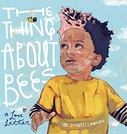
This unique book is a love letter written as a poem from the author, Shabazz Larkin, to his two sons. This artist, author, and activist is learning to overcome his fear of our most amazing pollinators --bees! With careful research and experiences with his sons, Larkin is learning to be fearless and wants to teach kids to be brave when facing their fears.Lexile Level: Not availableGuided Reading Level: Not availableGenre: FictionPre-Reading
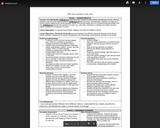
A folk tale and fairy tale unit plan created for use with third graders.